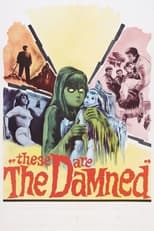John Chard
Jul 21, 2019
9/10
I live with one fact. A power has been released that will melt these stones. We must be ready when the time comes.
The Damned (AKA: These Are The Damned) is directed by Joseph Losey and adapted to screenplay by Evan Jones from the novel The Children of Light written by H.L. Lawrence. It stars Macdonald Carey, Shirley Anne Field, Oliver Reed, Alexander Knox, Viveca Lindfors and Walter Gotell. Music is by James Bernard and cinematography by Arthur Grant.
The South Coast of England, and a middle aged American tourist, a Teddy Boy gang leader and his troubled sister are thrust together into a deadly scenario deep below the cliffs of Weymouth...
Blacklisted by Hollywood, Joseph Losey moved to Britain to continue his artistic leanings. 1963 saw the release of two Losey movies, the much lauded The Servant and also The Damned, the latter of which was finished in 1961 but held back for reasons that are not exactly clear. As it transpires, The Damned is something of an under seen gem, a unique picture that defies genre classification, one of Hammer Films' oddest productions but all the more brilliant for it.
From the off it should be stated that this is not a film for those wishing to be cheered up, from a brutal mugging at the start to a finale that will haunt your dreams, pessimism and bleakness pervades the narrative. This is in the vein of The Quatermass series of films, tinged with a touch of John Wyndham's Midwich Cuckoos, yet for the fist part of the film there's no clue as to where the narrative will take you.
The back drop is a sunny and vibrant seaside town (Weymouth one of my favourite British resorts), an irritatingly catchy tune (Black Leather Rock) is being sung as we follow the meeting of the principal characters. From here you think this is a film about teenage angst, a Black Rebel Motorcycle Club themed picture, where the perils of gang youth is born and the divide between the young and the old is caustically dissected. Yet this is not the case at all, this is merely a cataclysmic meeting of integrity and troubled souls that's going somewhere terribly sad, the vagaries of fate dealing its deadly hand.
Losey then instills the picture with potent characterisations and striking imagery as we head towards what will be a fascinating and clinically cruel last third of the film. The brother and sister relationship between King and Joan is drip fed with smart dialogue, we don't need it spelled out, but we know that from King's side of things it's badly unhealthy. In the middle is Simon, trying to build a relationship with Joan under trying circumstances. At first it's hard to accept a "clearly too old" Simon as a romantic partner for a sultry Joan, but as back stories are dangled it's not inconceivable that Joan would seek solace in the arms of an older man.
The Children of Light.
On the outer edges, for a while, are Bernard (Knox) and Freya (Lindfors), he's a scientist, she's a sculptress, they themselves are part of a weird relationship. He's mysterious and soon to become the focal point of a terrible secret, she's eccentric and spends her time at her cliff top studio crafting weird sculptures, the latter of which Losey gleefully enjoys framing to keep the atmosphere edgy, the images are lasting and used to great impact as The Damned reveals its hand, and what a hand it is. Enter the science fiction, enter the government and their shifty dalliances, enter the children, the children of light...
It's a socko final third of cinema, both narratively and in viewing Losey's skill at creating striking compositions (while he garners impressive performances from his cast as well, especially Lindfors). It becomes thrilling yet deeply profound as it spins towards its bleak finale. It can be argued that its core sentiment (message) is heavily handled, and that Carey is a touch unsuitable as an all action hero type, but the film rises above these minor issues. For once the camera pulls away from the cliffs to reveal a swanky seaside town, the cries of children still ringing in our ears, you know you have watched something pretty special. 9/10
One of Hammer's unsung classics, The Damned can be found on The Icons of Suspense Hammer Collection. Region 1, it appears with five other films, two of which - Cash On Demand/Never Take Sweets from A Stranger - are also little gems waiting to be discovered. Great transfers for viewing pleasure, I can't recommend this collection highly enough.
